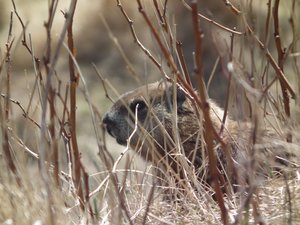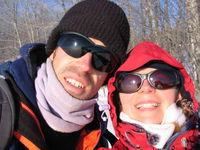Advertisement

 Groundhog
Groundhog
Cape d'OrOut on the far-flung eastern edge of mainland Canada is the small maritime province of Nova Scotia. We decided to do a smaller trip together this year due to our schedules, so we opted to stay in Canada and do a bit of road trip to explore Canada's Atlantic seaboard...
Halifax We flew into Halifax and stomped through drizzle and sleet to get to the B&B in the downtown core. Next morning was wet snow and particularly gloomy, so coffees and hot chocolates were plentiful as we slowly loitered around the city streets. The imposing Citadel on the hill above town was officially closed and half buried in snow, but we still made it inside the grounds and enjoyed the ramparts and cannons that once guarded the city. There were only two or three other tourists there - so it was quite special. Many of the sites we visited were either closed for the season or unstaffed. It worked out rather well for us as we often had the entire area to ourselves.
Cape Breton Island We picked up our rental car and tootled up the coast to Cape Breton Island in the north of Nova Scotia.

 Nova Scotia High
Nova Scotia High
Cape Breton Highlands National ParkAnd amongst the magic of being the only tourists to see the sights, we stumbled upon the East Coast Music Week of 2016. Live music from some of our eastern Canadian talent made our next couple of days inspired in addition to some great pub food and locally brewed stout on-tap... Life is good...
Louisbourg We were not aware that the Fortress of Louisbourg was closed on Sundays. The day we went was, well, a Sunday. Fate smiled upon us as the the cheery caretaker enthusiastically gave us a private tour! He loved taking us through the rooms and telling stories of the huge fortress. Two sieges took place at Louisbourg, the most significant was the siege of 1758. It was quite the turning point in the French-English struggle for what is now modern day Canada. A magnificent site with centuries of history.
Ring-ring! Neither of us own a smart phone. We do share a flip-top cell phone though, and are increasingly at odds against the fast moving, high speed communication age in which we now exist. However, we often ponder the handiness of the smart phone and we are thinking of getting with the times
and purchasing the aforementioned gadgets. But first we did a bit of research - and what better place to start than the Alexander Graham Bell Museum and National Historic Site in the small town of Baddeck.
We learned that Mr. Bell had a fascination with language and phonemics (the smallest of sounds). He and Thomas Edison were working on developing a hearing aid, when they accidentally discovered how to bounce sound at the speed of light using an electrical current.
In 1876, the first words were spoken over a very simple telephone: "Mr. Watson, come here, I want to see you". The phone was born.
Now that we fully understand the discovery and the evolution of phones, we feel better prepared for our possible future purchase of a smart phones... Prior to visiting the museum, we thought that Apples and Blackberries were some of the ingredients of a fruit salad. (Really? no, not really, but it's a funny line, though).
The Highlands. The dramatic Cape Breton Highlands National Park treated us to some lovely hikes all to ourselves. Spring was springing up everywhere we looked, despite still having to wear a light toque and gloves.

 East Coast
East Coast
Cape Breton Highlands National ParkA bit of wind, some chirpy squirrels, a few snow banks, and leaves waiting to emerge as the buds grew bigger with the longer days.
Giant Tides and Kathy Biggest tides on the planet, they say! Indeed they are correct. The Bay of Fundy greeted us with some moisturizing weather, as we explored the inlet of Minas Basin. As the North Atlantic tries to squeeze massive amounts of water into the narrowing channel, there is simply not enough room for all that water to go, so instead it piles up... And up!
The tides can rise and fall more than 16 metres (52 ft) twice a day (depending on the moon), churning up a vast muddy bottom and creating treacherous currents, rip tides and bores. As we hiked along the shoreline and high cliff tops, we watched the water charge in and out from the stunning red beaches of this extraordinary region.
Kathy, our host in Parrsboro, was a charming and generous lady with an infectious laugh and a colourful East Coast vocabulary. We spent many an hour listening to stories about her travels and misadventures. It was hard to say good bye to Kathy and

 The Skyline Trail
The Skyline Trail
Boots for the sloppy sections... Cape Breton Highlands National Parkthis charming little hostel. It was also hard, fighting over the maple syrup that she gave to us as a parting gift.
Deeper into the tidal funnel of the bay, we explored the UNESCO world heritage site of Joggins where a mother load of fossils have been discovered. Most of the fossils are of plants from the "coal age" or the carboniferous period. Only about 360 to 300 million years ago, give or take.... it may have been on a Tuesday.
So what this means, is... in order to make fossil fuels, just put a bunch of plants down, add oxygen to the atmosphere, then wait 360 million years, and if the conditions are right, you'll have oil or coal! Easy!
Dave and Theresa...
Advertisement
Tot: 0.399s; Tpl: 0.015s; cc: 34; qc: 165; dbt: 0.2555s; 1; m:domysql w:travelblog (10.17.0.13); sld: 1;
; mem: 1.5mb
























D MJ Binkley
Dave and Merry Jo Binkley
Off season travel
We often travel in off season and find it can be charming and a bit isolated. We love going in museums and such when we are the only ones there. Certainly peak season offers better weather and the buzz of activity but your quiet solitude has something to be desired. Dave joined the smart phone world a couple of years ago and has been very happy. He said the Smithsonian called and wanted his flip phone. ha ha.